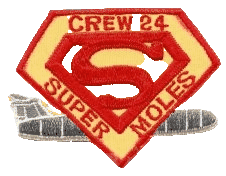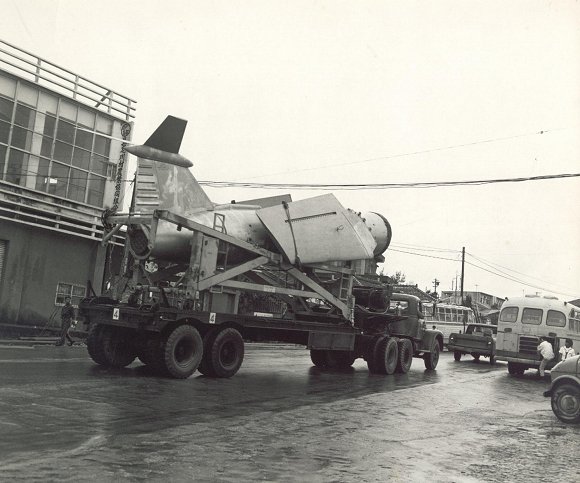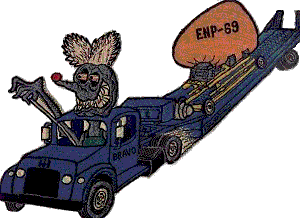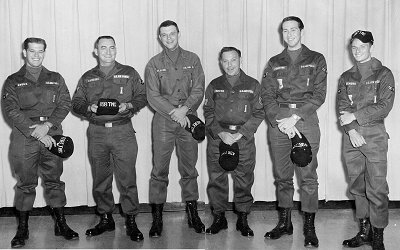|
Sembach Air Base
Hahn Air Base
Bitburg Air Base
Kadena Air Base
Osan AB
Tainan AB
Lowry AFB
Wheelus AB
Orlando AFB
Camp Happiness
Missile History I
Missile History II
Missile History III
The MM-1
Collectibles
Home Page
| 498th Tactical Missile GroupKadena Air Base, Okinawa
"Secretary of Defense Robert S. McNamara directed in early 1962 that the existence of the TM-76B weapons system on Okinawa "was not to be publicized in any way." He directed that the "missile, warhead section, and nose sections be transported to and from the launch sites under a canvas cover." Fearing political maneuvering and protests from Communist sympathizers on Okinawa and in Japan, the 498th TMG was directed to be identified by initials only." | U.S. Air Force Tactical Missiles 1949-1969 The Pioneers, copyright 2008, by George Mindling and Robert Bolton, Lulu.com press |
.jpg) The 100 Ton Launch Bay Door headed toward Launch Enable! USAF Photo coutesy of Dennis Cralley,sr. (dcralleysr@cox.net) |
 |

U.S. Air Force Tactical MissilesBy the Editors of this Website!Beyond the Web Page... The only book devoted exclusively to the Matador and Mace Tactical Missiles. The book reveals the story from the initial idea that became the first U.S. pilotless bomber, through the politically troubled development of the ever evolving deployment methods of the Matador and Mace Tactical Missiles. It covers the Units, Groups, Squadrons and Wing that fielded the missiles. From the United States test sites, Europe, Asia and North Africa nothing is omitted. All phases of the application of these two missiles by the U.S. Air Force (and West German Luftwaffe) are included, from the first tentative launches of the XSSM-A-1 Matador in January 1949, to the tense alert duty of the Cuban Missile Crisis, and the final launch of a MQM13A in May of 1977. The maintenance, logistics and launch, the men, equipment and tactics are all there. |
"Bob, George, I finished your book 2 days after I received it. Couldn't put it down. It was incredible reading and incredibly detailed information." Kent Washburn (KWASH55@aol.com) Mace B, Kadena, Okinawa
"George and Bob. I want you both to know how much I enjoyed reading and how much I admire and appreciate what you have accomplished in developing and publishing "The Pioneers." It is truly an outstanding piece of work, reflecting the time and effort required to produce it, but is also a formidable contribution to our military history. I mentioned in some earlier correspondence that I was a little disappointed in the relatively small amount of information regarding the Operating Location/Guidance Sites but you largely made up for it with this magnificent book."
Dale Lake (daleflake@yahoo.com) 601st Tactical Control Squadron, 38th TMW, Hamm, Germany
"I just finished your book, The Pioneers, et al. Please accept my "job well done!" Not only is it informative, but it's very readable. I'd also like to complement you on how well you footnoted it. You have shown that a scholarly work can be both instructive and enjoyable." Michael Roof (lavinaschnur@hotmail.com) SGM USA (Ret.)
|  ISBN 978-0-557-00029-6
"Very good work with great detail." Col. Charlie Simpson, USAF, Retired
Executive Director
Association of Air Force Missileers
"George, the book arrived on Tuesday while I was off to France. Of course, I quickly read the chapter about Germany's quiet step into the realm of nuclear armament. You know, this is still a widely ignored fact over here...
...For me it is fascinating to see what the picture really was in the 1950s and 1960s as opposed to what the official communication of the time wanted people to believe. A fascinating book shedding some light on the early days of tactical nuclear missiles as well as the political background that even today is still largely hidden behind the propaganda of the time. Can't wait to read the rest of it." Burkhard Domke
Harsefeld, Germany
| "I have your excellent book on USAF tactical missiles. I actually witnessed the decommissioning of the Maces at Wüscheim back in 1966." Paul Offen
Talitha, Tye Common Road
Billericay
Essex CM12 9PX
UK
"I just wanted to drop you a line and tell you how much I enjoyed the book that you and Bob wrote. The history was of particluar interest to me and my brother who was a history Professor at the University of Wisconsin. He also thought the book was well written, and he now knows what his little brother, (me), did while in Germany for three years." George Joseph Snyder (gjsnyder@lanset.com)
71st TMS, Steinborn, Germany
"...by the way, I read your book, it was great, thanks for writing it." Hack Hunton (hack@sstelco.com) Mace B, Kadena, Okinawa |
US Air Force Tactical Missiles © 2008 - George Mindling and Robert Bolton | |
Inspired by the 38th TMW Website, George Mindling and Robert Bolton co-authored US Air Force Tactical Missiles 1949 - 1969: The Pioneers ©2008, the story of America's first operational missiles, from the Matador to the Mace, from Taiwan, Korea, and Okinawa to Germany, including Lowry, Orlando, Holloman, Santa Rosa Island at Eglin, and even Camp Happiness! |
|
Dieses Buch ist ein Muss für alle, die im Rahmen ihres Dienstes bei der U.S. Air Force mit den frühen Marschflugkörpern zu tun hatten, aber auch für deutsche Militärarchäologen, die in der Eifel, im Hunsrück oder im Pfälzer Wald schon über rätselhafte Hinterlassenschaften gestolpert sind. Nach mehr als 40 Jahren wird endlich eine Fälle von Fakten, Informationen und Geschichten zu den zwischen 1954 und 1969 in Deutschland stationierten, mit Automwaffen ausgerüsteten amerikanischen Matador und Mace auf den Tisch gelegt. Ausführlich und lebendig erzählen George Mindling und Bob Bolton von den jungen Missilemen, die im März 1954 erstmals in Bitburg ankamen - noch ganz grün im Gesicht, weil auf dem Atlantik schwerer Sturm geherrscht hatte. Von den T-33-Flugzeugen, die aus übungsgründen so taten, als wären sie Matador-Flugkörper, über die Startstellungen hinweg in Richtung deutsch-deutsche Grenze donnerten und sich von der Gegenseite nur nicht erwischen lassen durften. Oder von der Kuba-Krise, als die US Air Force Europe auf DEFCON 3 ging und an die Mechaniker in Bitburg Munition für ihre Karabiner ausgegeben wurde.
Augenzeugen sagen dazu: "Wir hätten die Vögel auf jeden Fall innerhalb von 15 Minuten in der Luft haben müssen!" Es ist lebendige Militärgeschichte, die nun nicht der Vergessenheit anheimfällt, sondern jedermann zugänglich wird - auch für die ortsansässige Bevölkerung, die heute endlich erfährt, was sich damals in ihrer Nachbarschaft zugetragen hat. Den beiden Autoren gebührt der Dank.
Klaus Stark (klaus_stark@t-online.de)
Berlin, Germany
This book is not only a must for all those who served in the U.S. Air Force with the early cruise missiles, but also for German military archeologists who have been puzzling over relics stumbled across in the Eifel, the Hunsrück and the Palatinate Forests. After more than 40 years, we finally have a wealth of facts, information and stories, from 1954 to 1969, of the nuclear equipped American Matador and Mace missiles stationed in Germany placed on the table.
With detailed and vivid descriptions, George Mindling and Bob Bolton talk about the young Missilemen who arrived for the first time in March, 1954, in Bitburg - still green in the face, having prevailed the Atlantic crossing in major storm. Of the T-33 aircraft which practiced as if they Matador missiles launched in the direction of German-German border, or from the Cuban missile crisis, when the U.S. Air Force Europe went on DEFCON 3 and was issued ammunition to the mechanics in Bitburg for their rifles. Eyewitnesses say: "We would have to have the birds in the air in any event within 15 minutes!"
It is vital military history that is prey to oblivion, but is now accessible to everyone - even for the local population, which today finally learns what happened at that time in their neighborhood.
The two authors deserve thanks for saving the history.
Klaus Stark,
klaus_stark@t-online.de
Berlin, Germany
|

|
 Launch Squadron Headquarters Sign |  |  |
|

I am currently the historian at the 18th Wing, Kadena AB, and am researching the history of the 498 TMG from 1961 to 1969. I have the 313th Air Division histories, as well as the 498th histories for the whole time, but I would like to get some input from the people who served in the unit at that time. I am looking for any personal anecdotes; things that stand out as highlights/low points of the tour; specific information about the unit. I am working on a monograph for the Air Force History and Museum Program, should be ready by next year. Would love to hear from any old members of the 498th.
Thanks
MSgt Joe Orr (Joe.Orr@kadena.af.mil)
18th Wing Historian |
 |

"Crew #1 was the first to run up a combat ready missile engine in launch bay #A2 for launch capability testing. All systems were tested up to the depressing of the launch button. Everything worked as specked and the Pentagon “had its moneys worth” well spent. (But what about the latrines?)" "After completion, all was nominal until the Cuban Missile crisis. Crew briefings grew to be about an hour long.. Crew change over took more time to relay the “info” to the out going shift. The upgrade to DEFCON 2
[Ed note: Only Strategic Air Command, CONUS, raised to DEFCON 2. PACAF and USAFE rose to DEFON 3. SAC remained on DEFCON 2 until Nov 15.]
made every one concerned for the future of the human race. Missile down time for any reason was not authorized, except for missile malfunctions. For every missile down we had to have a F-105 pulled aside and “specially loaded out” to cover our targets. Those pilots did not appreciate being strapped in the cockpit for hours in order to have the same response time as our missiles. Fortunately, there were only a couple of missiles that “malfunctioned” during that time period." John Bordne (jcbordne@hotmail.com)
|

The Kadena Controversy
In response to inquiries about my knowledge and documentation about a possible live-warhead Mace missile launch from Kadena Air Base during the Cuban Missile crisis, I present the following references and related links about the event. This is NOT operation Sunset Lily, a scheduled launch of an inert Mace-B six years later that was canceled and did not happen. Operation Sunset Lily was used as the backstory for former Launch Officer Carlo Croce's novel Launch Enable.
The initial Bulletin of Atomic Scientist article is at: The Okinawa Missiles of October
The response from Stars and Stripes Magazine is at: Missileers refute claim The photographs used from this web site by author Travis Tritten were used with my permission.
The Bordne/UN Interview in .mp3 format (43Mb) is available for download at Bordne Interview
My response to Aaron Tovish, Director of the 2020 Vision Campaign of Mayors for Peace, author of the original article, is at:
Letter to Aaron Tovish
George Mindling, Webmaster/Co-author U.S. Air Force Tactical Missiles 1949 – 1969 The Pioneers
|


Launch Crew 27 - Site 3
I was looking for something on the CGM-13B to decorate the office when I came across your site. It is great, it brings back many great memories. After attending training in Orlando, I served as a Mech 4 on Crew 27, Site 3 from January 1966 to June 1967. I have included a picture of one of the few mementos that survived the years and moves --- a “Turtles” crew patch from my old “498th black hat.”
The advertisement for Orion Beer is very appropriate and speaks to the primary off-duty interest of us “young troops.” Between Orion beer, Instant money and the pawn shops, it a miracle that some of us live to tell the of tour. I had the opportunity to visit the old barracks in 1988. The most significant difference was women residents and the TV lounge was empty on an off payday weekend.
David L. King, CMSGT, (Ret) ( Dlk2161@aol.com) |

 A TM-76B (CGM-13B) barely clears an overhead power line at the village of Deragawa enroute to a launch site from the missile maintenance area, Kadena Air Base, Okinawa.
Photo coutesy of Chuck Headlee (headlee@abcs.com). |
 Launch Crew Foxy 26 - Site 3I've searched the web for the last 7 years for any notion of the 498th. I stumbled onto your site for the 498th TMG this afternoon andwas totally delighted. I signed the guest register and in such a hurry that I forgot to add my bio to my entry. If you can add the following, I'd appreciate it greatly...
I was assigned a Mech 5 to that group from 1968-1969 and to the Site 3 on the Pacific side. My crew designation was: Foxy 26.Those members were:
Site Commander - Maj G. E. Gibbons
NCOIC - M/Sgt H.R. Sunde
Mascot - Fred J. Frogg (a 3' high plastic frog)
Foxy 26 Crew
Launch Officer - Capt. R.J. Moes
Crew Chief - S/Sgt. A.T. Banish
Mech 1 - L.M.Herington
Mech 3 - A1C J.K. Clineman
Mech 4 - S/Sgt. K.R. Dreese
Mech 5 - A1C E. L. Faulkner
I also have a "Yearbook/Album" printed in 1968, endorsed by the Group Commander, Col.Peter H. Spear. I'd be more than delightedto receive emails from all crew members.
Thanks for your efforts to assemble this web site
Ed Faulkner (elfbiz2@msn.com) |

 "Nose Pickers" - Kadena, Okinawa"The speed limit on the island was 30 mph, and only 20 mph if we were hauling a nose section, warhead or bird. Tiedown checks on the return trip from site 3, usually done in front of a grocery store, were frequent. Cold Orion beer was only 35 cents a quart."
Charles Headlee 498th MMS (headlee@abcs.com) |
-Ready.jpg) Nose Pickers at work...
A Mace-B nose change
Photo courtesy of Dennis Cralley, Sr. (dcralleysr@cox.net) |

The Paris Steam Bath
"I worked MACE Site 3 on rotating shifts along with everyone else. This was four days on day shift, two days off, four on afternoon shift, two days off, four on midnight and four days off."
"At the end of one of these shift rotations we were pretty tired and in need of somegrooming. So, on the first day off after the midnight shift, we would go to Gate No.2 street to a barber shop to get a haircut and a massage from a female barber.
They would cut your hair, and rub your back with a hand vibrator. Ah, life was good.
Then it was off the Paris Steam Bath for, what else, a steam bath, and a hot bath, and another massage. These were delivered by, if you werelucky, a cute female. If you weren't so lucky, you got mama-san. Ah, life was good and getting better.
Then it was across the street to the local greasy spoon for a decent meal. The food was hot, cheap, and always better than the chow hall. I followed this routine for the entire 18 months on Okinawa. What I miss to this day though is the massage at the Paris Steam bath. When, ifyou were lucky, the cute female would walk up and down your back, you could hear every vertebra crack ... geeez that felt good."
Tim Lewinski (timlew@chartermi.net)
Kadena AB Okinawa - MACE Site #3 (Aug 1963- Feb 1965) |

Launch Crew 33 - Site 4
 This was Launch Crew 33 Site 4Left to Right:A2C Anger (Site Power)A1C Cousins (Nuclear Weapons)Lt. Richard Mellick (Launch Officer)TSgt Carter (Crew Chief)A2C Larry Johnston (Guidance & Launch)A2C Frank Bender (Airframe& Engine)
Please feel free to share with anyone.
Great Web Page.... Thanks for the memories.
Larry Johnston (ljohnsto@comcast.net) |
 A memorandum issued by Secretary of Defense Robert S. McNamara on March 23, 1963, named "Selected Projects for CY 63," initiated a project that planned to do a live launch of a CGM-13C Mace “B” from a combat hardsite at Kadena. Secretary McNamara directed the Joint Chiefs of Staff to "develop plans for measuring more accurately the reliability of our missile systems and for raising the reliability of such systems to acceptable levels." Apparently, Secretary McNamara considered U.S. Air Force missile systems reliability to be unacceptable. The history of the 313th Air Division states: "The Joint Chiefs replied that the various Commanders-in-Chief would continue to evaluate the reliability of each missile system they committed to the Single Integrated Operational Plan (SIOP). Although this gradually evolved into operational testing of the strategic missile systems only, there was every reason to consider the evaluation of SIOP-committed tactical missile systems as consistent with Secretary McNamara's intent." "Complying" with the intent of McNamara's plan resulted in the planning of one of the few, if not the only, live launches of a combat ready missile from an active launch pad that actually had Victor Alert responsibilities! The plan to launch an operational Mace missile from Bolo Point, Site 1, at Kadena Air Base, Okinawa, during the Vietnam War had begun."
U.S. Air Force Tactical Missiles 1949-1969 The Pioneers, copyright 2008, by George Mindling and Robert Bolton, Lulu.com press |  |
The Novel by former Mace Missileman, Launch Officer Carlo Croce, depicted the planned live fire from an operational site, called Operation Sunset Lily. The operation has been de-classified and is part of the Unit History, 313th Air Division, PACAF | 
|
 
Launch Crew 66 |
 Kadena's Last Launch Site |  The last remaining Mace B Hard site on Okinawa was converted to a Buddhist temple. The Soka Gakkai Okinawa Training Center at Naha has been the site of several international peace conventions and meetings. Photo coutesy of Clancy at (clancy@ctinet.net) |
 | April 11, 2006 "Chinese Friendship Delegation Visits Soka Gakkai's Okinawa Training Center"
 "Chinese friendship delegation tours an exhibit at the Okinawa Training CenterOn April 10, a delegation from the Chinese People's Association for Friendship with Foreign Countries, led by President Chen Haosu, visited Soka Gakkai's Okinawa Training Center and were welcomed by local members. There, the Chinese delegates toured the Okinawa World Peace Monument, which was built upon the site of a dismantled U.S. MACE B missile base. The colossal concrete mass measuring 100 meters by 9 meters, and with a wall 1.5 meters thick, was used as a launch pad for nuclear missiles targeted at China. Mr. Chen expressed admiration for Mr. Ikeda's idea to leave the site untouched as a perpetual reminder of the horrors of war and for the fact that many youth come to the center to study about peace." "Chinese friendship delegation tours an exhibit at the Okinawa Training CenterOn April 10, a delegation from the Chinese People's Association for Friendship with Foreign Countries, led by President Chen Haosu, visited Soka Gakkai's Okinawa Training Center and were welcomed by local members. There, the Chinese delegates toured the Okinawa World Peace Monument, which was built upon the site of a dismantled U.S. MACE B missile base. The colossal concrete mass measuring 100 meters by 9 meters, and with a wall 1.5 meters thick, was used as a launch pad for nuclear missiles targeted at China. Mr. Chen expressed admiration for Mr. Ikeda's idea to leave the site untouched as a perpetual reminder of the horrors of war and for the fact that many youth come to the center to study about peace."
The above article ©  Used in compliance with SGI web site copyright requirements 2007 http://www.sgi.org/ Used in compliance with SGI web site copyright requirements 2007 http://www.sgi.org/ |
 This page is in no way sponsored or endorsed by the United States Air Force.
Opinions and views expressed are those of the author and not necessarily those of the Department of the Air Force.
|
Web Page Design and Development by
George Mindling - Port Charlotte, Florida
©George Mindling - 2003-2006, 2018 All Rights Reserved
|
|

